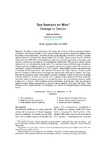Mostrar o rexistro simple do ítem
The Descent of Man
| dc.contributor.author | López Palma, Helena | |
| dc.date.accessioned | 2018-02-06T12:41:58Z | |
| dc.date.available | 2018-02-06T12:41:58Z | |
| dc.date.issued | 2009 | |
| dc.identifier.citation | López Palma, Helena. The Descent of Man: Homage to Darwin. International Conference on Contemporary Music”, A Coruña, 25-27 april, 2010. | es_ES |
| dc.identifier.uri | http://hdl.handle.net/2183/20072 | |
| dc.description | El documento es una versión ampliada de la ponencia presentada en la International Conference on Contemporary Music | es_ES |
| dc.description.abstract | [Abstract] The DM is a sonic simulation of the origin and evolution of human language inspired in Darwin’s ”The Descent of Man” (1871) and his conjectures on the evolution of hominid species descendant of ancestral homo. It focuses on the sounds allegedly uttered by 5 species: Australopithecus afarensis (4,2-2,6 mill.), Homo habilis (2,5-1,6 mill.), Homo erectus (1 mill.-100.000), Homo antecesor (800.000). Australopithecus afarensis uses barks, pant hoots, screaming vocalizations to express his emotions and to communicate with fellows. The syntax is holistic and the sentences are not articulated in simple units. The sentences express different type of emotions:whispers, growls, complaints, pleasure, acceptance, power, fear, danger alarm. The scream sentences have 2 peaks of frequencies of ca. 2 or 3 octaves. Homo habilis invents tools and develops a technique of hard percussion. We represent this specie by simple rhythms. Homo ergaster discovers symmetry and develops a technique for carving stone (Achealense Culture). We represent him by percussive sound with complex symmetric rhythms. Homo erectus lives in groups of hunter-gatherers. He discovers melody, and is capable of identifying intermediate points between the extreme frequency peaks of the scream-Sentences. He utters melody sentences within a range of 1 -2 octaves. Those sentences are not articulated in phonemes. They are uttered as mmm-sentences. Homo antecesor live in groups of hunter-gatherer. They burry the dead . They develop a more complex melodic-tonal language. Are capable of holding dialogues and narrating stories. | es_ES |
| dc.description.sponsorship | Xunta de Galicia; IN809 A 2009/109 | es_ES |
| dc.language.iso | eng | es_ES |
| dc.publisher | Universidadeda Coruña | es_ES |
| dc.rights | Atribución-NoComercial-SinDerivadas 4.0 International | es_ES |
| dc.rights.uri | http://creativecommons.org/licenses/by-nc-nd/3.0/es/ | * |
| dc.subject | Sonic simulation | es_ES |
| dc.subject | Hominids language | es_ES |
| dc.title | The Descent of Man | es_ES |
| dc.title.alternative | Homage to Darwin | es_ES |
| dc.type | info:eu-repo/semantics/conferenceObject | es_ES |
| dc.rights.access | info:eu-repo/semantics/openAccess | es_ES |
| UDC.startPage | 1 | es_ES |
| UDC.endPage | 16 | es_ES |
| UDC.conferenceTitle | International Conference on Contemporary Music”, A Coruña, 25-27 april, 2010. | es_ES |








